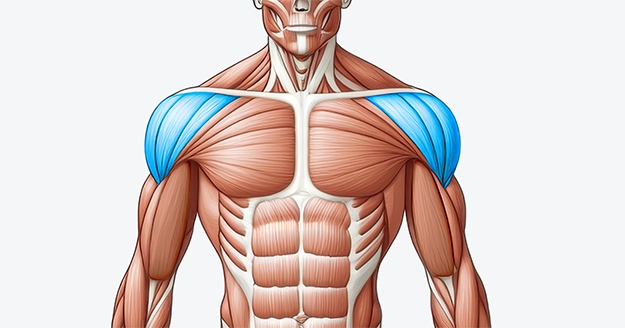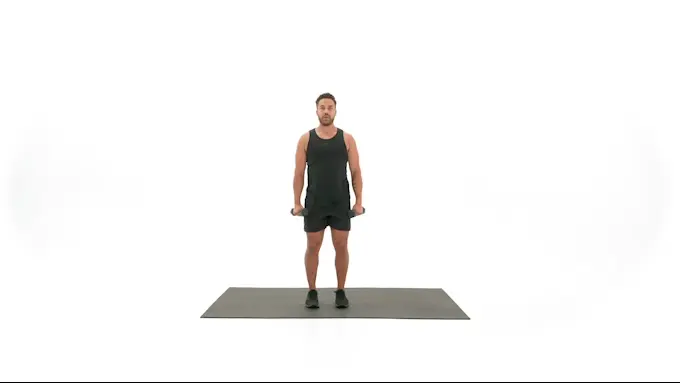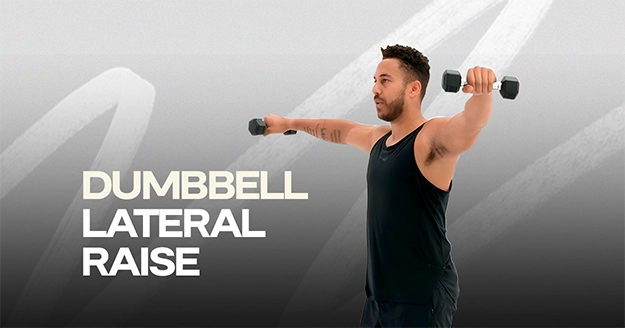Exercise Profile
Dumbbell Lateral Raise Overview
The dumbbell lateral raise is a strength exercise that isolates the shoulders, mainly the lateral deltoids.
For beginners, this exercise is a great way to develop shoulder strength and improve posture. Advanced lifters can increase the weight to further engage the shoulder muscles.
Dumbbell Lateral Raises can be integrated into your routine as part of an upper body workout, focusing on shoulder development, or as part of a total-body exercise.

Dumbbell Lateral Raise Instructions
Step 1: Grab a set of dumbbells with your hands at your sides and palms facing you. Stand with feet hip-width apart.
Step 2: In a controlled manner, raise the dumbbells to the side until they’re around shoulder height. Make sure your arms are parallel to the floor, with elbows slightly bent.
Step 3: Pause briefly, then slowly lower the weights.
Step 4: Before the dumbbells touch your side or hang at the bottom, lift them again. Keep your core and glutes contracted throughout the movement.
Step 5: Continue for the desired number of repetitions, maintaining good form and control.

Common Dumbbell Lateral Raise Variations
Dumbbell Lateral Raises are great for targeting your shoulders, but you can mix it up with different variations to make them easier or harder, or to focus on different parts of your shoulders. Here are other dumbbell lateral raise variations you can try:
Dumbbell Lateral Raise Tips
- Do your repetitions in a slow, controlled manner. Avoid swinging the weights.
- Lead with your elbows when lifting the weights to ensure your delts are worked.
- Raise your arms just to shoulder height. Going higher can shift the focus away from your shoulders and strain your traps.
- Start with lighter weights before increasing resistance to ensure proper form.
Dumbbell Lateral Raise Common Mistakes
- Leaning Back: This removes the focus from the shoulders. When you lean back, you are likely to use momentum and your upper traps to lift the weight.
- Too Fast: Doing the exercise too fast can cause sloppiness in form and can also reduce the tension on your shoulders, making it less effective.
- Too Heavy: Lifting heavy can lead to bad form, like swinging or using momentum.
Frequently Asked Questions
Why do my traps hurt during Dumbbell Lateral Raises?
This could mean you’re shrugging your shoulders or using too much weight. Focus on keeping your shoulders down and using controlled movements to isolate your delts.
What is dumbbell lateral raise good for?
Dumbbell Lat raises are key for building well-defined, rounded shoulders. Beyond enhancing your appearance, they improve shoulder mobility, range of motion, and stability.
Should dumbbell lateral raise be light or heavy?
Beginners should start with lighter weights. For those with more experience, they can increase the weight, but ensure you keep your form tight throughout each rep.
Should dumbbell lateral raises be slow or fast?
The key for effective dumbbell lat exercises is to slow down the tempo and maintain control throughout the movement. Slowing the pace increases the time your muscles are under tension, which enhances muscle engagement and boosts the effectiveness of the workout.
Post your post-workout selfies in IG and tag @trainestapp, #trainest, or DM them to us to get a shoutout on Trainest Stories!


